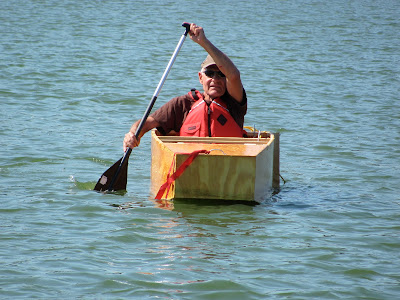After a full agenda of family activities and days of
blistering heat, I was able to get my kayak out on the water today in the cool
of the morning. Since Lake Alvin
is so close and always calling, after my morning read and two mugs of coffee, I
headed out to the public access area on the southwestern end of the lake.
I wondered about the effect of the drought on the lake,
especially on the waterway leading up into Nine Mile Creek. Although the lake
seems to be down about 5 or 6 inches, as demonstrated by the water marks on
rocks, only limited effects were observed on the cruise today. Lake Alvin seems less affected by low
water than Beaver Lake or Lake Lakota or even the Big Sioux River.
There was some heavy algae in the waters around the dock and
at points on the run up into the creek.
Generally, however, the scum on the surface tended to disappear as I
continued. There was plenty of
suspended algae in the water, but that seems common as the summer wears on.
Jumping carps at times reminded me of rapids in the area streams. I was even splashed a couple of times
from near jumps by big carp.
As usual, I headed across the lake and up into Nine Mile
Creek. While there is some shallow
water at the mouth of the creek, I was able to easily negotiate that section
and move into the deeper channel that continued up past the bridge and into the
narrow waters that continue south.
Nine Mile Creek still has ample water to navigate about a
mile inland. Just short of the
usual blockage, I ran into water too shallow to continue and easily turned
around for the cruise back downstream into the main body of the lake.
 |
| Eastern Kingbird on shore of Lake Alvin |
Going downstream is a great opportunity to observe bird
life, and I found myself stalking interesting birds in hopes of a good
photograph.
For some time I have been concerned about my endurance and
strength for paddling, especially for lake waters with no current and only the
wind as a variable. Today I wanted
to get in some stiff paddling down to the north end of the lake, and I
concentrated on maintaining a brisk pace.
 |
| Great Blue Heron on Lake Alvin |
Along the way, I came across a great blue heron that had
skipped several hops ahead of me on the way to the northern shore.
Passing the Recreation Area launching ramp, I noticed an odd
looking craft with two guys standing nearby. After finishing my paddle, I returned to the Recreation Area
in the northwestern part of the park and met two gents who were messing around
with that craft while fishing.
One of the guys was the builder of this craft. He set himself the challenge of building
a boat for less than $100, and the result is an 8-foot pram with a high
freeboard. The craft is 8-feet
long because that is the size of a sheet of ordinary plywood purchased at a
local lumber outlet, and the cost includes the wood, varnish, glue, and fixtures.
An outrigger was also constructed to provide stability for
fishing. With the outrigger, the
paddler sits in the center on a lawnchair and uses a “j” stroke to propel the
boat. Without the outrigger, the
paddler has to sit on the bottom of the boat; the sides are too high to permit
a double blade paddle, and it is awkward to switch sides with the high
sides. So, a single paddle is
used. I left as the craft was pulled out of the lake and loaded into the back of a black Honda Element.
After visiting with these two guys, I headed up into the
hiking trail that has recently been developed leading from the parking area of
the launching ramp into the brush along the shore and up into the hills
overlooking the lake.
When I returned, I found Zach, of
Zach’s Kayaks, at the
launching ramp with a pick-up full of kayaks as he was outfitting a young lady
who was about to move out on her cruise.
Zach’s Kayaks seems to me to provide a great service to someone who
wants to go out for a paddle now and then without the burden of owning a boat –
or for someone who wants to try out the sport.
My cruise today was about two hours; once again, I felt as
though I need to go to Lake Alvin more often for the exercise and ease of
transportation. It is only 15
minutes from my driveway, and there seems to nearly be something new and
interesting to observe.
 |
American Bittern on Lake Alvin
|























